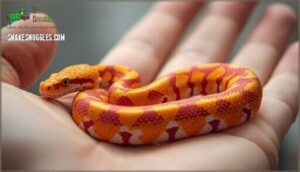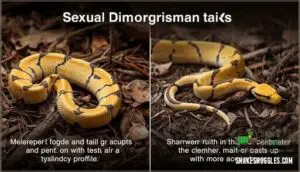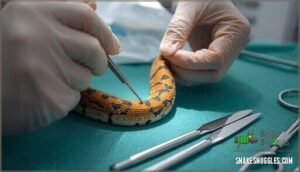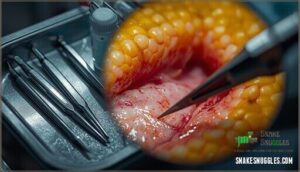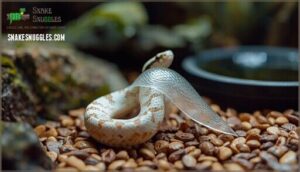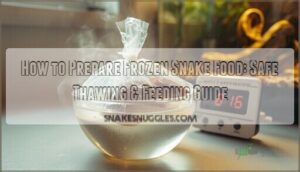This site is supported by our readers. We may earn a commission, at no cost to you, if you purchase through links.

This anatomical sleight of hand makes sexing these popular serpents one of the trickier aspects of snake keeping. You need to look closer, feel more carefully, or employ specialized techniques that range from simple visual cues to procedures that demand precision. Understanding these methods protects both your snake’s health and your confidence as a keeper, whether you’re planning to breed or simply want to know if "Stripe" should be "Sophia.
Table Of Contents
- Key Takeaways
- How to Sex a Corn Snake?
- Overview of Corn Snake Sexing
- Visual Inspection Techniques
- Invasive Sexing Methods
- Risks Associated With Invasive Methods
- Non-Invasive Alternatives
- Frequently Asked Questions (FAQs)
- Do corn snakes sex?
- How do you find the sex of a corn snake?
- How do you identify a corn snake?
- How do you know if a corn snake is female?
- How do you stop a corn snake from biting you?
- How do you identify a snake’s sex?
- What is the most reliable method for sexing a corn snake?
- Can you sex a corn snake without invasive methods?
- At what age can you reliably sex a corn snake?
- Is it safe to sex a corn snake on your own?
- Conclusion
Key Takeaways
- Corn snakes lack external sex organs, making visual identification challenging, but males typically display thicker, longer tails (14-17% of body length) that taper gradually, while females show shorter tails (10-12% of body length) with abrupt tapering past the vent.
- Probing achieves the highest accuracy (95-99%) for determining sex by measuring internal depth—males accommodate probes 8-16 subcaudal scales deep into hemipenial pockets, while females stop at only 2-4 scales—but improper technique causes injury in up to 15% of untrained attempts.
- Non-invasive alternatives like visual tail assessment reach only 60-80% accuracy, while DNA testing from shed skin offers near-perfect results without the stress or physical risks associated with probing or popping hemipenes.
- Professional veterinary examination remains the safest option for definitive sex determination, using sterile techniques and proper sedation to minimize trauma while avoiding the complications that amateur handlers frequently cause.
How to Sex a Corn Snake?
Why does figuring out whether your corn snake is male or female feel like solving a puzzle? That’s because these snakes don’t give many obvious clues. You can’t spot external reproductive organs, and both sexes look remarkably similar in color and size.
Determining corn snake sex requires specific methods of sexing, each with varying accuracy. Visual inspection offers a starting point—males usually have longer, thicker tails that taper gradually, while females show shorter tails with abrupt tapering.
For more precision, invasive techniques like probing reach over 95% accuracy in experienced hands, making them the best method for sex verification. Popping works well for juvenile sexing in snakes under six months old, achieving roughly 90% accuracy when done correctly. However, ethical considerations demand expert training before attempting these procedures, as improper technique can injure your snake.
If you’re breeding corn snakes, accurate sexing becomes essential, but safety always comes first when you sex a corn snake. The probing technique involves inserting a lubricated probe into the cloacal opening to measure the depth.
Overview of Corn Snake Sexing
Sexing corn snakes hinges on identifying internal reproductive structures—specifically, the paired hemipenes in males or their absence in females. You’ll find that snake gender determination methods vary in both accuracy and complexity.
The probing method achieves the highest sexing accuracy rates, inserting a probe to depths of 8–16 subcaudal scales in males versus only 3 in females. For hatchling sexing, popping offers a reliable option in snakes under a few weeks old by manually everting the hemipenes.
Visual assessment of tail tapering provides a starting point—males show thicker, longer tails that accommodate hemipenes, while females display abrupt tapering. Visual inspections can also be used, though this method isn’t always foolproof. Understanding these probing depth differences and hemipene identification markers helps you approach determining corn snake sex with confidence.
Visual Inspection Techniques
Visual inspection offers a practical starting point for determining your corn snake’s sex without invasive techniques. Two main physical characteristics will be examined: the shape and length of the tail, and the number of subcaudal scales. These methods work best on snakes that are close to or have reached sexual maturity.
Tail Shape and Length
When you examine your corn snake’s tail, you’re looking at one of the clearest windows into its sex—thanks to tail dimorphism driven by hemipenial influence in males. Male corn snakes generally show tails that measure 14–17% of their total body length, compared to just 10–12% in females. This tail length difference stems from males carrying two to three additional caudal vertebrae to house their reproductive organs.
You’ll notice males maintain a thick, cylindrical profile that tapers gradually at a shallow angle of 5–8 degrees from the cloaca backward. Females, by contrast, narrow abruptly within the first centimeter or two past the vent, with taper angles exceeding 15 degrees.
This morphometric analysis of tail characteristics—combining tail shape, tail length, and taper angle—achieves around 80% accuracy in adult snake tail identification, though it’s less reliable in juveniles.
Scale Count Method
Another approach involves counting scales, though it comes with important limitations. The scale count method examines subcaudal scales—those running from the cloacal vent to the tail tip. Here’s how you do it:
- Locate the cloacal vent and identify where the subcaudal scales begin
- Count each single scale along the tail’s underside to the tip (shed skin works well since scale borders show up clearly)
- Apply the traditional threshold: fewer than 65 suggests female, more than 70 suggests male
However, this technique has serious accuracy problems. Mitchell et al. found that males average 69 scales and females around 65.5, but with substantial overlap. Statistical analysis shows this 65/70 threshold only achieves about 60% accuracy—barely better than guessing.
Geographic variation, hybridization effects, and incubation temperatures all influence subcaudal scale counts, making static thresholds unreliable. Modern herpetologists consider scale counting an approximate indicator at best, far less dependable than probing’s 95%+ accuracy for sexing corn snakes.
Invasive Sexing Methods
When visual methods fall short, you’ll need more direct techniques to confirm your corn snake’s sex.
Probing and popping are hands-on approaches that examine the snake’s internal anatomy. Both require careful handling and precise technique to avoid injury.
Probing
When you need a definitive answer, the probing method offers precision that visual techniques can’t match. This invasive approach uses a slender, lubricated stainless steel probe inserted gently into your snake’s cloaca, angled toward the tail.
In males, probe depth reaches 40–70 mm as it slides into the hemipenial pockets; females stop short at just 6–12 mm where scent glands block further entry. Equipment sterilization between uses prevents infection, and proper handling techniques—supporting the body while maintaining gentle control—keep stress minimal.
Accuracy factors like snake size and handler experience matter; when done correctly by someone trained, probing corn snakes achieves near-perfect reliability. Ethical considerations demand you weigh this invasive method’s necessity against non-invasive alternatives.
Popping Hemipenes
When done correctly, popping hemipenes offers a quick way to confirm sex in young corn snakes—but it’s not something you should attempt without proper training. This technique involves applying gentle pressure just below the cloaca while rolling your thumb forward to trigger eversion mechanics. If your snake is male, the hemipenes will briefly protrude as red-tipped bulges.
Juvenile Safety: Popping works best on hatchlings under four months old, when less developed muscle tone allows safer hemipenal eversion. Older snakes resist the pressure and face higher injury risk.
Technique Accuracy: Trained handlers achieve 96% accuracy with this popping method, but untrained individuals drop below 80%. False results happen when weak pressure fails to evert hemipenes or when female structures are misidentified.
Ethical Concerns: The American Veterinary Medical Association classifies popping corn snakes as Level II invasiveness, requiring professional supervision. Excessive force causes cloacal bruising or permanent prolapse in 3–5% of mishandled cases—damage that can affect future breeding.
Training standards demand at least 10 hours of supervised instruction before you attempt popping hemipenes independently.
Risks Associated With Invasive Methods
While probing and popping can accurately determine your corn snake’s sex, these methods aren’t without risk. Improper technique can lead to serious injury, infection, or unnecessary stress for your snake. Understanding what can go wrong helps you make informed decisions about whether to attempt these procedures yourself or seek professional help.
Potential for Organ Damage
When you insert a probe incorrectly, you’re basically gambling with your snake’s internal organs. Probing complications can cause serious cloacal trauma, including hemorrhage or scarring when the probe goes beyond the safe 6–8 subcaudal scale depth in males or 2–4 in females. Hemipene injury occurs in up to 15% of mishandled cases, sometimes leading to permanent prolapse or sterility. Amateur attempts carry particular risks—spinal damage from improper restraint affects juveniles especially hard, with tail or spine injuries accounting for roughly 10% of post-sexing veterinary visits.
| Type of Organ Damage | Common Cause |
|---|---|
| Cloacal wall rupture | Over-insertion of probe |
| Hemipene prolapse | Excessive popping pressure |
| Vertebral dislocation | Incorrect restraint technique |
| Bacterial infection | Contaminated instruments |
The risks associated with invasive methods highlight why veterinary advice matters. Self-taught probing shows a three-times higher rate of mechanical injury compared with professional examination.
Stress and Infection Risks
Handling stress and infection prevention aren’t just precautions—they’re lifelines for your corn snake. Restraint and probing spike stress hormones up to three times baseline within minutes, weakening immune defenses and feeding responses. Contaminated tools introduce bacteria like Pseudomonas, which can turn septic within 48–72 hours. Trauma mitigation demands expertise you can’t fake.
- Stress hormones compromise wound healing and reproductive fitness in corn snakes
- Unsterilized equipment spreads respiratory pathogens and opportunistic infections
- Ethical considerations require veterinary-level skill to balance diagnosis with animal welfare
Invasive methods carry risks associated with invasive methods that amateur handling magnifies dangerously.
Non-Invasive Alternatives
If you’d rather avoid the risks that come with probing or popping, you’re not out of options. A veterinary exam or careful observation of shed skin can give you answers without putting your snake through unnecessary stress.
These methods won’t give you instant results, but they’re safer alternatives worth considering.
Veterinary Examination
When your corn snake’s sex remains uncertain, veterinary examination offers the best approach for sex determination. Reptile veterinarians use cloacal probing or ultrasonography under sterile conditions, achieving 94–100% veterinary accuracy when properly performed. Here’s what makes professional assessment worthwhile:
- Imaging techniques like ultrasound and CT scans visualize hemipenes without physical intrusion, reducing stress while confirming reproductive anatomy.
- Training standards upheld by the Association of Reptilian and Amphibian Veterinarians make certain your veterinarian has certification-level expertise in snake sexing procedures.
- Ethical considerations guide every step—sedation options minimize struggling, and post-procedure care includes 24-hour monitoring for any signs of distress.
- Diagnostic precision distinguishes males (probe depth 2–3 inches) from females (0.25 inches or less) with minimal risk when correct probe size matches your snake’s body length.
Professional veterinary advice eliminates guesswork while prioritizing your snake’s welfare throughout the process.
Observations From Shed Skin
Your snake’s shed skin holds subtle clues you can examine without causing stress. Female corn snakes often leave behind scent gland residue visible as two oval-shaped dots near the vent region, while male sheds show fainter or more widely spaced marks.
DNA extraction techniques using shed skins achieve near 100% methodological accuracy—companies analyze the tissue to identify males (one DNA band) from females (two bands). For practical sampling, collect the shed immediately after molting and store it dry.
This noninvasive comparison to probing makes shed-based sexing a snake-friendly alternative, though visual gland assessment alone remains less reliable than genetic testing.
Frequently Asked Questions (FAQs)
Do corn snakes sex?
Like the old saying goes, "you can’t judge a book by its cover"—and that’s especially true with corn snakes.
Yes, corn snakes have distinct biological sexes: male and female. Sexual maturity, mating behavior, and reproductive health all depend on correctly identifying gender, which promotes genetic diversity and ideal breeding frequency.
How do you find the sex of a corn snake?
You can find the sex of your corn snake through visual inspection, probing, or popping. Visual methods—checking tail shape and scale counts—work for quick assessments but only reach 60-70% accuracy. Invasive techniques like probing offer over 95% reliability when done correctly by experienced handlers or vets.
How do you identify a corn snake?
Spotting a corn snake is like reading nature’s signature—each mark tells a story. You’ll recognize them by their slender body, measuring 30-48 inches, distinctive color morphs ranging from orange to reddish-brown, and scale patterns featuring large irregular blotches outlined in black.
Additionally, their checkered belly resembles corn kernels in most wild specimens.
How do you know if a corn snake is female?
You can identify a female corn snake by her shorter tail that tapers immediately after the cloaca and her rounded cloaca shape. Females generally have 59-70 subcaudal scales, fewer than males.
Visual accuracy improves considerably after 16-18 months when these tail shape differences become more pronounced.
How do you stop a corn snake from biting you?
A nervous snake handler once got bitten during feeding time—a mistake easily avoided. To prevent bites, handle your corn snake 1-2 times weekly using calm, confident movements.
Support the body gently, avoid handling after feeding, and provide proper hiding spots to reduce stress and defensive behaviors, building trust over time.
How do you identify a snake’s sex?
You can determine a snake’s sex through several methods for gender identification. Visual inspection examines tail shape and subcaudal scale counts, though dimorphism factors make this less reliable in juveniles.
Probing and popping hemipenes offer higher sexing accuracy but demand handler experience to prevent injury.
Ethical concerns favor non-invasive alternatives like genetic testing from shed skin, which achieves 80-90% accuracy when determining corn snake gender without stress or trauma risks.
What is the most reliable method for sexing a corn snake?
Probing is the most reliable method for sexing adult corn snakes, with accuracy rates reaching 95-99% when performed by experienced handlers. DNA testing offers near-perfect results but involves lab costs, while visual inspection and scale counts are less dependable.
Can you sex a corn snake without invasive methods?
Yes, you can. Visual sexing relies on tail shape—males generally show a thicker, gradually tapering tail beyond the vent, while females taper more abruptly.
Scale counting also helps: over 140 subcaudal scales suggests male, under 130 indicates female.
DNA testing from shed skin offers the most accurate noninvasive option.
At what age can you reliably sex a corn snake?
Most corn snake owners can start visual sex determination around 6-12 months when tail shape differences emerge, though accuracy improves closer to sexual maturity at 16-18 months.
Probing delivers the most reliable results once juveniles reach 18 months, when reproductive organs are fully developed enough for safe examination.
Is it safe to sex a corn snake on your own?
Without the right training, attempting methods for gender identification on your own carries real risks. DIY sexing risks include tissue damage, infection, and lasting stress—with studies showing improper probing causes internal harm in up to 15% of untrained attempts.
Self-taught sexing risks serious harm—improper probing injures 15% of corn snakes through tissue damage, infection, and lasting stress
Professional assistance is needed, which means choosing safe alternatives like veterinary exams or DNA testing.
Ethical considerations and handling precautions matter: your corn snake’s safety depends on expert care, not guesswork.
Conclusion
A snake that once seemed inscrutable now reveals its secrets—you’ve learned how to sex a corn snake through methods ranging from gentle observation to precision techniques. The tail’s taper, the scale count beneath the cloaca, or a veterinarian’s practiced probe can all confirm what external anatomy conceals.
Choose your approach based on your experience level and comfort with handling. Visual cues work well for patient keepers willing to compare multiple specimens, while professional examination eliminates guesswork entirely.
Your snake benefits most when you prioritize its safety over curiosity, selecting methods that minimize stress and improve accuracy.
- https://www.youtube.com/watch?v=_zhBNpNe_oA
- https://reptifiles.com/corn-snake-care-guide/sick-corn-snake-diseases-health/corn-snake-sexing/
- https://journal.biotrop.org/index.php/biotropia/article/download/probing-and-contrast-radiography-for-gender-determination/822/10985
- https://www.reddit.com/r/cornsnakes/comments/16za6qq/counting_subcaudal_scales_is_not_a_valid_sexing/
- https://www.sciencedirect.com/topics/agricultural-and-biological-sciences/cloaca

